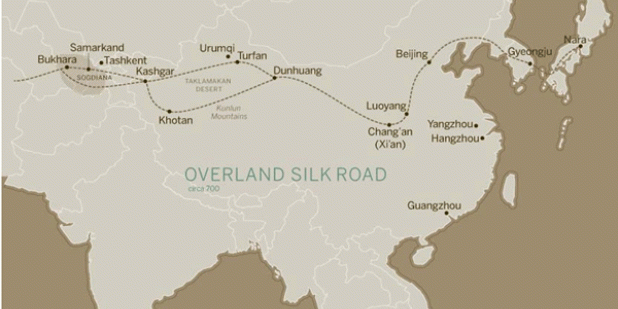Happy Lunar New Year from the USC US-China Institute!
Silk Road Luxuries from China
Through the exchange of luxury goods via the Silk Road, Chinese artisans adopted Western designs and techniques that came to distinguish the Tang dynasty.

Long before the adventures of Marco Polo sparked European interest in Asia, the Silk Road connected Mediterranean ports in the west to centers of production and trade in China and beyond. For more than two thousand years this vast network of caravan trails has linked oasis settlements across the Central Asian desert, and many of those ancient overland routes are still in use today. Then as now, the Silk Road enabled the long-distance exchange of luxury goods—colorful silks, silver and gold objects, delicate glass, and even the legendary peaches of Samarkand—as well as the sharing of ideas, customs, and religious beliefs. The impact of foreign imports on the arts of China reached exceptional heights during the Tang dynasty (618–907), when craftsmen explored new materials, forms, and decorative patterns introduced from the West.
Under the Tang, China was united for the first time in four hundred years. The flourishing young empire, supported by effective government administration and strong armies, expanded into Central Asia. During this era of peace and stability, the capital at Chang'an (modern Xi'an) became the largest city in the world. Its cosmopolitan society sought fresh ideas and expensive goods from afar.
Traders and artisans from the ancient kingdom of Sogdiana, located in southern Uzbekistan and western Tajikistan, were especially active in this exchange. Their ancient Iranian language was the primary basis of trade for centuries. Communities of Sogdian traders extended from Anatolia to India and Sri Lanka and on to East Asia. Their interaction with China remained strong until 755, when An Lushan, a Sogdian favorite at the Chinese court, led an unsuccessful rebellion against the emperor. By the time of the Mongol invasion in the thirteenth century, the Sogdians had disappeared completely.
This exhibition has been made possible through the generosity of the Thaw Charitable Trust.
Featured Articles
We note the passing of many prominent individuals who played some role in U.S.-China affairs, whether in politics, economics or in helping people in one place understand the other.
Events
Ying Zhu looks at new developments for Chinese and global streaming services.
David Zweig examines China's talent recruitment efforts, particularly towards those scientists and engineers who left China for further study. U.S. universities, labs and companies have long brought in talent from China. Are such people still welcome?






